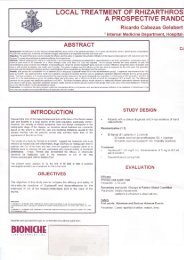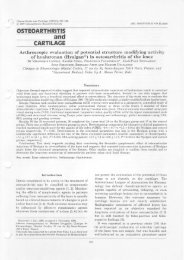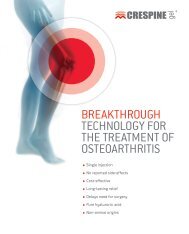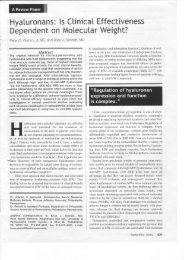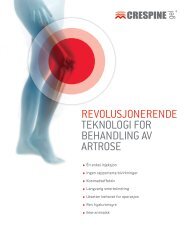Treatment forGolfer's Toe - Crespine Gel
Treatment forGolfer's Toe - Crespine Gel
Treatment forGolfer's Toe - Crespine Gel
Create successful ePaper yourself
Turn your PDF publications into a flip-book with our unique Google optimized e-Paper software.
interaction, and nearly unlimited frequency of use.<br />
Whether intra-articular FIA use in a smaller joint, such<br />
as the first MTB provides efficary and a low side-effect<br />
proflle similar to the knee is unknor,r,.n.<br />
Study Design<br />
The protocol and written informed consent for<br />
studies involving human subjects were approved by<br />
the Universityof Westem Ontario ReviewBoard.<br />
The study was a single-center, single-arm, openlabel<br />
trial with an B-week treatment phase. Within 12<br />
months, orthopedic and primary care physicians referred<br />
patients who had pain in the first MTP joint<br />
(unilateral only) and disability (described as reduced<br />
golfing activity without an acute injury event) for at<br />
least 3 months. In addition, all patients had radiogaphic<br />
evidence of osteoarthritis of the first MTP joint<br />
(ie, grade 1 to 3 hallu rigidus using the Regnauld classification<br />
ofjoint-space narrowing and osteophy'te formation).<br />
The subjects provided informed consent, had<br />
not taken NSAIDs for 2 weeks prior to entry, had not<br />
received intra-articular corticosteroid injection in the<br />
first MTP joint within the previous 3 months, did not<br />
have other lower- extremity musculoskeletal disability<br />
or pain, and had pain exceeding 45 Irrn on a 100-mm<br />
visual analogue scale (VAS) immediately following<br />
tiptoe walking for 10 m.<br />
After screening and enrollment, patients completed<br />
assessments and received a 1.0-mL intra-articular<br />
injecton of FIA (Suplasyn, Bioniche Life Sciences Inc,<br />
Belleville, Ontario; 20 mgl2 mL) in the first MTP joint.<br />
An experienced physician delivered the injections<br />
using a27-gauge needle. The toe was semiflexed and<br />
held in gentle traction without topical or local anesthesia<br />
during injection. One dose was administered each<br />
week (t 2 days) for B consecutive weeks in an unblinded<br />
fashion. Patients returned at 9 and 16 weeks and then<br />
self-selected a follow-up visit when theywould request<br />
a second series of injections based on retum of s1'rnptoms<br />
that interfered with their golf activity.<br />
Assessments<br />
Clinical assessments were performed prior to injection<br />
at baseline, at each of seven subsequent weekly<br />
treatment visits, at 16 weeks, and at the second series<br />
visit (28 to 76 weeks after the eighth injection). Adverse<br />
events were recorded at each srudv visit and classified<br />
using standard World Health O rgarrizatio n terminolo gy<br />
and coding. The primary efficacy measures rvere fust<br />
MTP joint pain after 5 minutes of seated rest and following<br />
completion of 10 m of tiptoe rvalking (assessed<br />
byVAS), range of plantar flexion and dorsiflexion of the<br />
first MTP joint (measured from the metatarsal to the<br />
proximal phalanx with a goniometer), and global<br />
patient satisfaction (GPS)(measured on a S-point categorical<br />
scale, with I representing completeh'unsatisfied<br />
and 5 completely satisfied).<br />
In addition to FIA injection therapv patients were<br />
permitted to use standard nonpharmacologic therapies,<br />
including rest, ice, compression, and elevation,<br />
(RICE) and orthoses, aspirin for cardiovascular disease<br />
prophylaxis up to 325 mg/day, and general analgesia<br />
using acetaminophen up to 1 g/dart NSAIDs were not<br />
allowed during HA treatment but were allowed at<br />
patient discretion during the follow-up posttreatment.<br />
Use of altemate treatment modalities was recorded at<br />
16 weeks and at follow-up visits.<br />
Statistical Analysis<br />
Changes in pain scores were evaluated using analysis<br />
of variance (ANOVA) for repeated measures. GPS<br />
was evaluated to determine the proportion of treatment<br />
responders at each treatment and at follow-up<br />
visits. Frequenry of adverse events over the treatment<br />
period and during follow-up were also recorded. level<br />
of statistical significance was accepted at P



